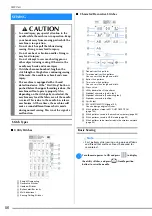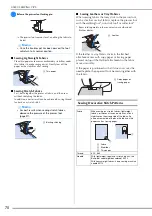
USEFUL SEWING TIPS
Se
w
in
g Ba
sics
69
2
Sewing Tips
■
Trial Sewing
Before starting your sewing project, we recommend
sewing trial stitches using thread and scrap fabric that are
the same as those used for your project.
While checking the sewing results, adjust the thread
tension as well as the stitch length and width according to
the number of fabric layers and stitch that is sewn.
■
Sewing Curves
Sew slowly while keeping the seam parallel with the
fabric edge as you guide the fabric around the curve.
Shorten the stitch length setting to obtain a fine stitch. Sew
slowly, keeping the seams parallel with the fabric edge as
you guide the fabric around the curve.
■
Changing Sewing Direction
Stop the machine. Leave the needle in the fabric, and
press
(Presser foot lifter button) to raise the presser
foot. Using the needle as a pivot, turn the fabric so that
you can sew in the new direction. Press
(Presser foot
lifter button) to lower the presser foot and start sewing.
The pivot setting is useful when changing the sewing
direction. (page 65)
Sewing Various Fabrics
■
Sewing Heavyweight Fabrics
The machine can sew fabrics up to 6 mm (approx. 1/4
inch) thick. If the thickness of a seam causes sewing to
occur at an angle, help guide the fabric by hand and sew
on the downward slope.
If the Fabric does not Fit under the Presser Foot
If the presser foot is in the up position, and you are sewing
heavyweight or multiple layers of fabric which do not fit
easily under the presser foot, use the presser foot lever to
raise the presser foot to its highest position. The fabric will
now fit under the presser foot.
If the Fabric does not Feed
If the fabric does not feed when starting to sew or when
sewing thick seams, press the presser foot locking pin on
the left side of presser foot “J”.
a
Raise the presser foot.
b
While keeping the presser foot locking pin on the left
side of presser foot “J” pressed in, press
(Presser
foot lifter button) to lower the presser foot.
USEFUL SEWING TIPS
Note
• Other factors, such as fabric thickness, stabilizer
material, etc., also have an effect on the stitch, so
you should always sew a few trial stitches before
beginning your project.
• When sewing decorative satin stitch or satin stitch
patterns, there may be shrinking or bunching of
stitches, so be sure to use a stabilizer material.
CAUTION
• Do not forcefully push fabrics more than 6 mm
(approx. 1/4 inch) thick through the machine.
This may cause the needle to break and cause
injury.
Содержание 882-W70
Страница 2: ......
Страница 12: ...CONTENTS 10 ...
Страница 56: ...CHANGING THE PRESSER FOOT 54 ...
Страница 57: ...Chapter 2 Sewing Basics ...
Страница 73: ...Chapter 3 Various Stitches ...
Страница 106: ...MY CUSTOM STITCH 104 ...
Страница 107: ...Chapter 4 Basic Embroidery ...
Страница 141: ...Chapter 5 Advanced Embroidery ...
Страница 156: ...EMBROIDERY APPLICATIONS 154 ...
Страница 157: ...Chapter 6 My Design Center ...
Страница 176: ...STIPPLING 174 ...
Страница 177: ...Chapter 7 Appendix ...
Страница 193: ...ERROR MESSAGES 191 Appendix 7 ...
Страница 205: ......
Страница 206: ......
Страница 207: ......
Страница 208: ......
Страница 209: ......
Страница 210: ......
Страница 211: ......
















































